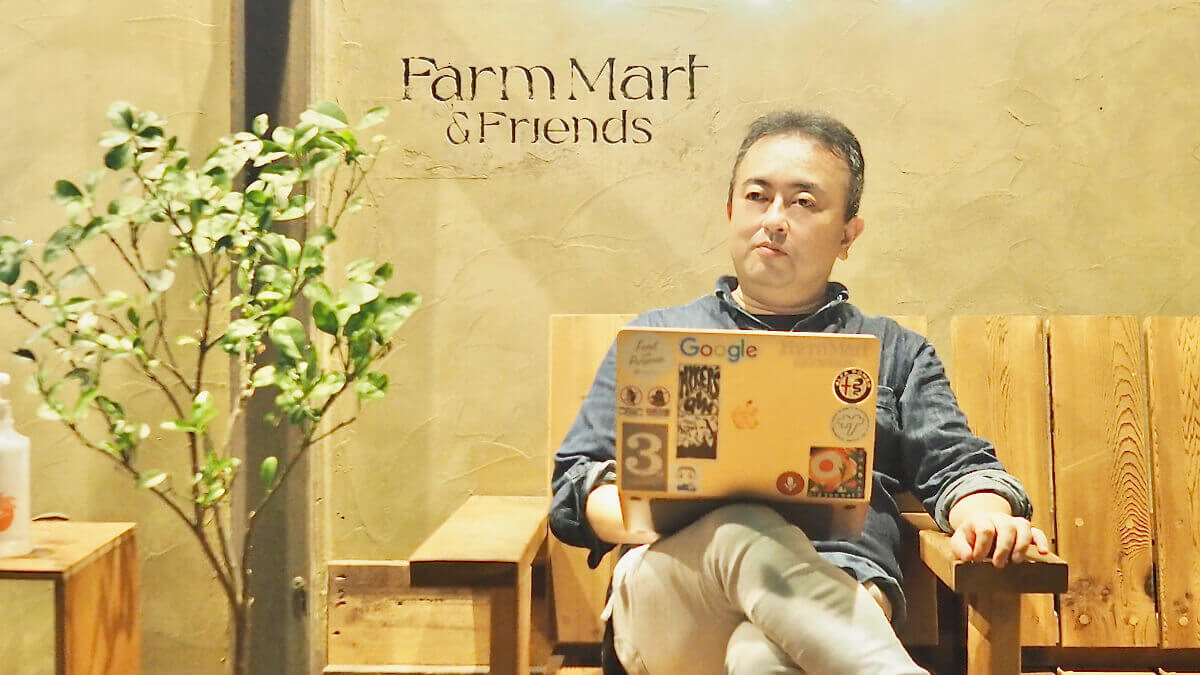こんにちは、ライターの飛田恵美子です。ものさすサイトで書くのは3回めです。
先日、とある会社の社員食堂にお邪魔する機会がありました。普段は入ることができない社食スペースで、社員価格のランチをいただけるとあってうれしかったのですが、実際に食べてみると「あれ?」と……。パスタはぼそぼそしていて、サラダは量が少なくしんなりしています。正直なところ、「金欠のときはありがたいけど、毎日これだと寂しいなぁ」という印象でした。
一方で、おいしくて栄養バランスも良く、毎日通いたくなってしまう社食を訪問したこともあります。最近の社食って、二極化しているのかなと思います。
前置きが長くなりましたが、モノサスには社食を運営・プロデュースするチーム「MONOSUS社食研」があるそうです。このチームを率いるのは、モノサスCDOの真鍋太一さんと、Google Japan 初代フードマネージャーで、その後、フードテックカンパニーnonpiの取締役を経て、2020年にモノサスに仲間入りした荒井茂太さん。10月には、東京・九段下に社食研が手がけた公益食堂「九段食堂 for the Public Good」がオープン。今回は荒井さんに、“オフィスにおける日常の「食」の未来”をテーマにお話を伺いました。
荒井茂太 MONOSUS社食研 食事業開発ディレクター
サッカー選手、プロバリスタとして活躍した後、2007年10月より約10年間、Google Japan 初代フードマネージャーを務める。2016年10月、株式会社nonpiに参画し、三菱地所、GSK、LINE、Indeedなどの社食を企画運営。2020年5月末でnonpi役員を退任し、顧問就任。同時にフードハブ・プロジェクト親会社のモノサスへ入社。
MONOSUS社食研
2020年よりモノサスの新しい事業としてスタート。「Good Food,Good job! 良い職は、良い食から」をモットーに、「働き方」を職と食が共にある「営み方」へシフトさせていきます。
会話が生まれ、イノベーションが起きる「社食3.0」
—— 荒井さんが社食に注目するようになった背景を教えてください。
グーグル・ジャパンでの経験が大きいですね。少し遡ってお話すると、社員食堂の歴史は、戦後復興期から高度経済成長期に至る過程のなかではじまっています。大手メーカーが郊外に従業員2000人規模の工場を建てたとき、周辺にはそんな人数をまかなえるほどのお店がないから社員食堂をつくったんです。当時必要だったのは、人数分の量を、早く、安く提供すること。2000人に対してクオリティの高い料理を出すのはなかなか難しいことですから、味は二の次でした。その風習がずっと続いてきてしまった。
ところがグーグルは、食を通じてのコミュニケーションを大切にしようとしたんです。ちゃんとリソースをかけ、さらにデータを活用して無駄を省いた。それを見て、社食には可能性があるなと気づきました。
—— というと?
飲食って、無駄が多いんですよ。普通の飲食店の場合、とても混む日もあれば、お客さんがまったく来ない日もある。でも、当日になってパートさんに「今日は暇だから来なくていいです」なんて言えませんよね。だから、日によっては収支がマイナスになってしまうんです。
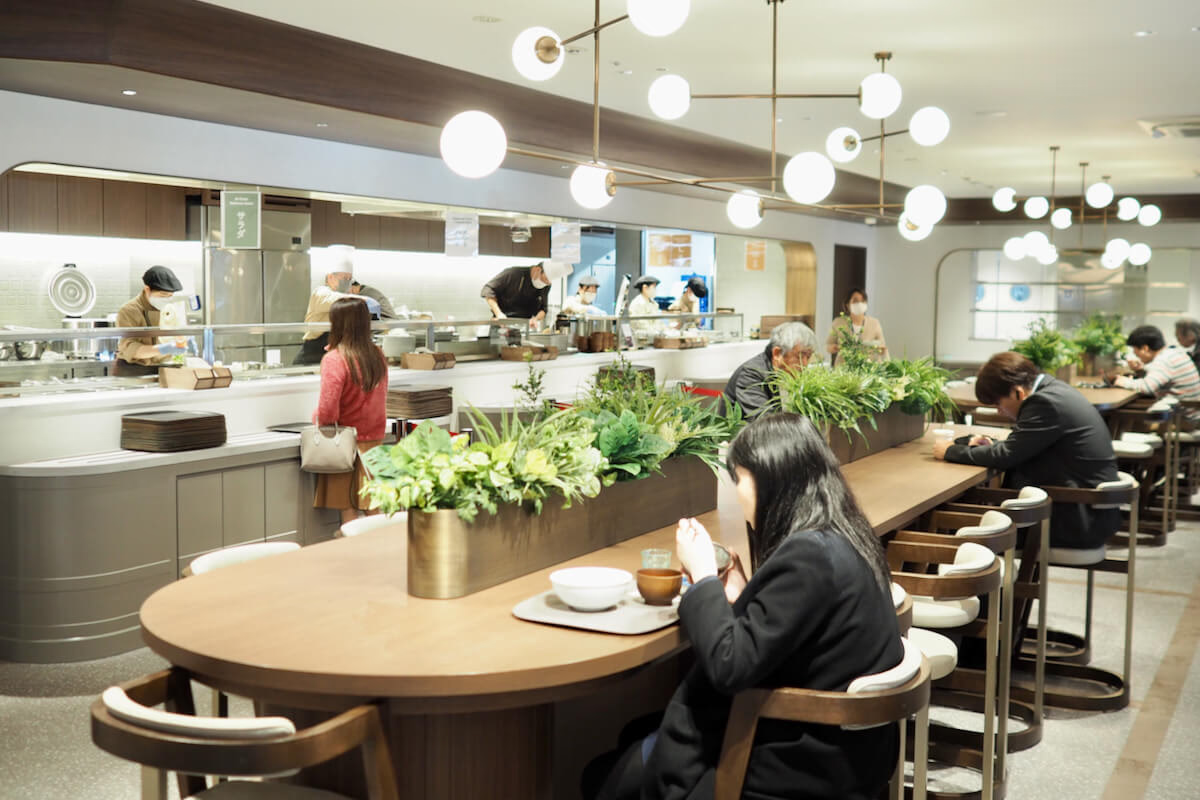
MONOSUS社食研で運営する九段食堂 KUDANーSHOKUDO for the Public Good
一方、社食の場合は特定多数を相手にするから、ある程度運営が安定しています。データを取るとさらに予測がしやすくなりますね。そうすると、有機農業でおいしい野菜をつくる生産者さんに「毎月これだけ仕入れます」と約束できます。生産者さんも「いいものをつくっても買ってもらえないかもしれない」という不安があると、安心して農業に取り組めないでしょう。社食はやり方次第で、つくる人にも食べる人にも、社会にもいいサイクルを生み出すことができるんです。
—— 荒井さんはよく新しい社員食堂のあり方を「社食3.0」と表現されていますね。
「社食1.0」はさきほどお話した、戦後復興期に生まれたお腹を満たす機能に特化した社員食堂です。その後2000年頃から、社員の健康を考え、栄養バランスが取れたおいしいメニューを提案する社食が増えてきました。これが「社食2.0」。でも、そこにも足りないものがあります。それは、「誰とどういう風に食べるか」。
グーグルの社食では、「社員やコミュニティがベストな状態でいるために、健康的な食事を選び食体験を楽しんでもらうこと」をミッションにしていました。料理や皿の大きさ、テーブルの配置などを含めてすべてが「会話が生まれるように」デザインされていること。それが「社食3.0」です。人が集まると会話がはじまり、そこから生まれるアイデアがイノベーションにつながります。実際に、gmailも社食での会話から生まれたと言われています。
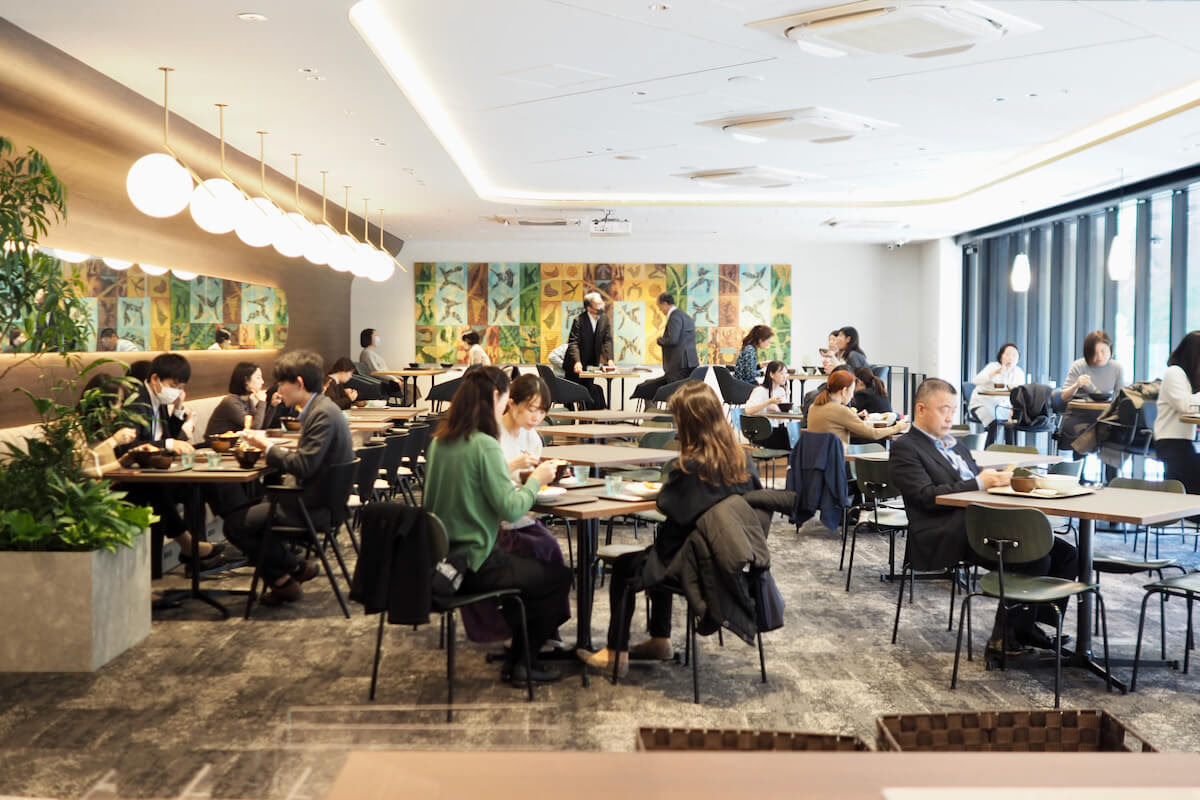
九段食堂 KUDANーSHOKUDO for the Public Good
—— 具体的にはどういった工夫をされていたのでしょうか。
1人で座るカウンター席をつくらず、会話が生まれやすい8人掛けのテーブル席を設置しました。そして、サラダバーには天狗の顔の形をしたナスや姫にんじんなど、普段目にしないような野菜を必ずひとつ入れました。驚きのある料理によって、「これ何だろう?」「味はどう?」と、隣の人に話しかけるきっかけを提供する狙いです。また、生産者を呼んだワークショップや豚の解体、餅つきなどのイベントも開催しました。別部署の人や社外の人とのコミュニケーションが生まれ、学びにもなると好評でした。
もうひとつ意識していたのが、社食スタッフが社員に積極的に話しかけること。グーグルでは社員のみなさんも僕らを「業者」ではなく「チームの一員」として見てくれていましたし、経営層からも「インタラクティブなコミュニケーションを大事にしてほしい」と言われていたので、80人の食堂スタッフに対して、「少なくとも20人は親しい社員をつくってください」と伝えました。そうすると、社員1600人をカバーできますよね。「最近忙しそうですね」とか「昨日は何を食べました?」とか、スタッフが親しみを持って話しかけることで、会話が生まれる場になるんです。自分たちのことをコミュニティマネージャーだと思って取り組んでいました。
「社食利用率5割」を達成できる理由
—— そうした魅力ある社食が増えている一方で、世の中にはまだあまりおいしいとは言えない社食も多い気がします。それはどうしてなのでしょうか。
業界の構造的な問題も大きいと思います。社食業界の市場規模は1兆7千億円ほどでずっと変わっていません。各社とも、売上を伸ばそうと思うと他社からシェアを奪うしかない。そうすると、買い手が強くなるんですね。コンペの要件が「500円で有機野菜を使ったメニューを提供してください」という無理なものだったりします。それで腕のいいシェフを雇っておいしい料理を出せというのが無茶な話です。
さらに、担当者がデータを取らず感覚的に「この味つけ薄くない?」と評価し、本当は多くの社員が満足していたのにレシピを改定しなければいけなくなる、ということもままあります。そうしたことが繰り返されると、提供側が主体的に考えて改善していく気概が薄れ、「言われたことをやる」という受け身の運営になっていくんです。
—— 荒井さんはそうした負のループにはまることはないのですか?
僕はコンペに参加するときに、「僕らはこういう理念のもと、こういうサービスを提供できます。ただ、いただいた条件では数字が合いません。ここはご相談させていただきたいです」というご相談をします。相手に提示された前提条件を鵜呑みにするのではなく、要望に最適な条件を双方できちんと話し合う事をしなければ、業界の良くない習慣はずっと変わりませんし、クライアントにとっても社員にとっても良い社食にはなりません。勇気を出して伝えることが必要なんです。
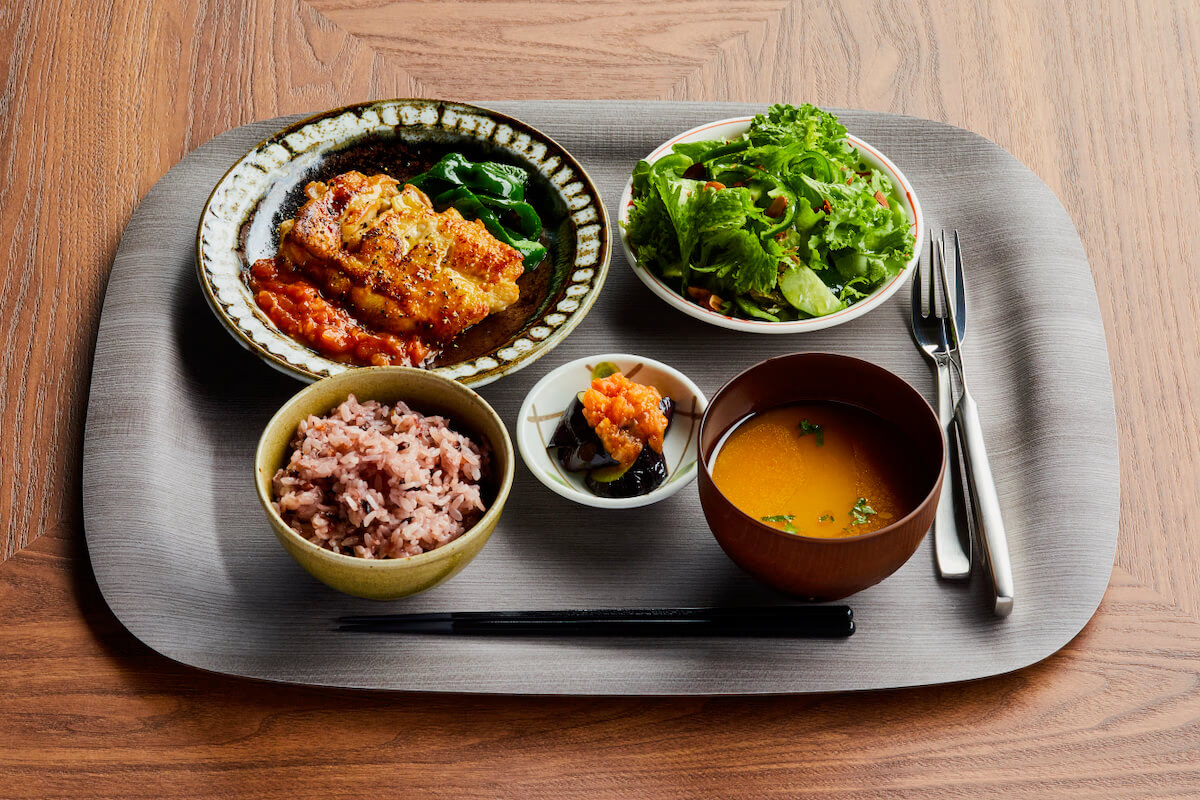
九段食堂では日替わりで定食を提供。素材は日本各地の関わりのある生産者から直送で届きます。
—— 前提条件を覆す提案をしても、ちゃんと受け入れてもらえるのですね。
相手の立場や事情を勘案しながら、現実的な提案をするようにしています。たとえば、「社員の方が払うのは500円で結構です。でも、750円のクオリティのものを500円で提供したら、僕たちが一食につき250円の赤字を負担することになります。その分を補助していただけませんか。その代わり、社食の利用率を何割まで上げてみせます」といったような提案をしますね。社食業界では利用率は3割行けばいいほうと言われていますが、僕はもっと利用率を高められると確信しています。
実際に、ある企業から社食の相談をされたときは、「最初の3か月は、以前の業者と同じ価格でやります。その間に利用率5割を達成したら補填金を入れてください」とお願いしました。その時点で利用率36%だったので14%増やし、補填金を入れてもらうことができました。
—— そこでちゃんと利用率5割を達成できるのがすごいですね。
社食は外食と違って日常の食なので、奇をてらう必要はありません。一汁三菜という日本の文化をベースにしながら、温かいものは温かく、冷たいものは冷たく提供するという、基本を忠実に継続することが大事です。ところが、「社員数が多いからメニューも増やさないといけない」と考えてしまい、忙しくなりすぎて基本が疎かになっている社食も多いんですよ。
でも、出数を分析すると、2〜3割のメニューで8割を占めていたりするんです。必要ないものを削ぎ落としていけばオペレーションは複雑にならず、温かいものをちゃんと温かいまま提供する余裕ができます。基本を維持するには、オペレーションを整えることが必要なんです。
小さな生産者をまとめて社食とつなぐ
—— そのほかに荒井さんが社食を運営するうえで大事にしていることはありますか?
なるべく添加物や化学調味料を使わず、旬のものを旬のときに手づくりで出すこと。「そんな簡単なことか」と思うかもしれないけど、実はそれが難しいんです。最初に厳しい条件を飲んでしまうと、提携先の社食全部で同じ素材を使い、年間を通して大量に仕入れる約束をする分値下げしてもらい、それでなんとか利益を出すという構造になりがちです。だから旬の野菜を柔軟に使うことができないんですよ。
—— 社食研と関わりも深いフードハブ・プロジェクトでは、「小さいものと、小さいものをつなぐ」、すなわち「少量生産と少量消費をつなぐ」ことをモットーにしていますよね。社食の場合は食数が多く「小さい」とは言えないと思うのですが……。
小さいものをまとめて中くらいにして、社食とつなぎたいと考えています。具体的にいうと、フードハブで神山の小さい農家さんたちの生産物をまとめて東京に送ってもらう、ということですね。ほかの地域でもそうした仕組みをつくって、食数に応じて提供できるようにしたいと思っています。東京の企業が生産者へのリスペクトを深め食の本質に向き合うようになったらほかにも派生するだろうし、日本全体で働く人の食が豊かになっていくんじゃないかと妄想しています。
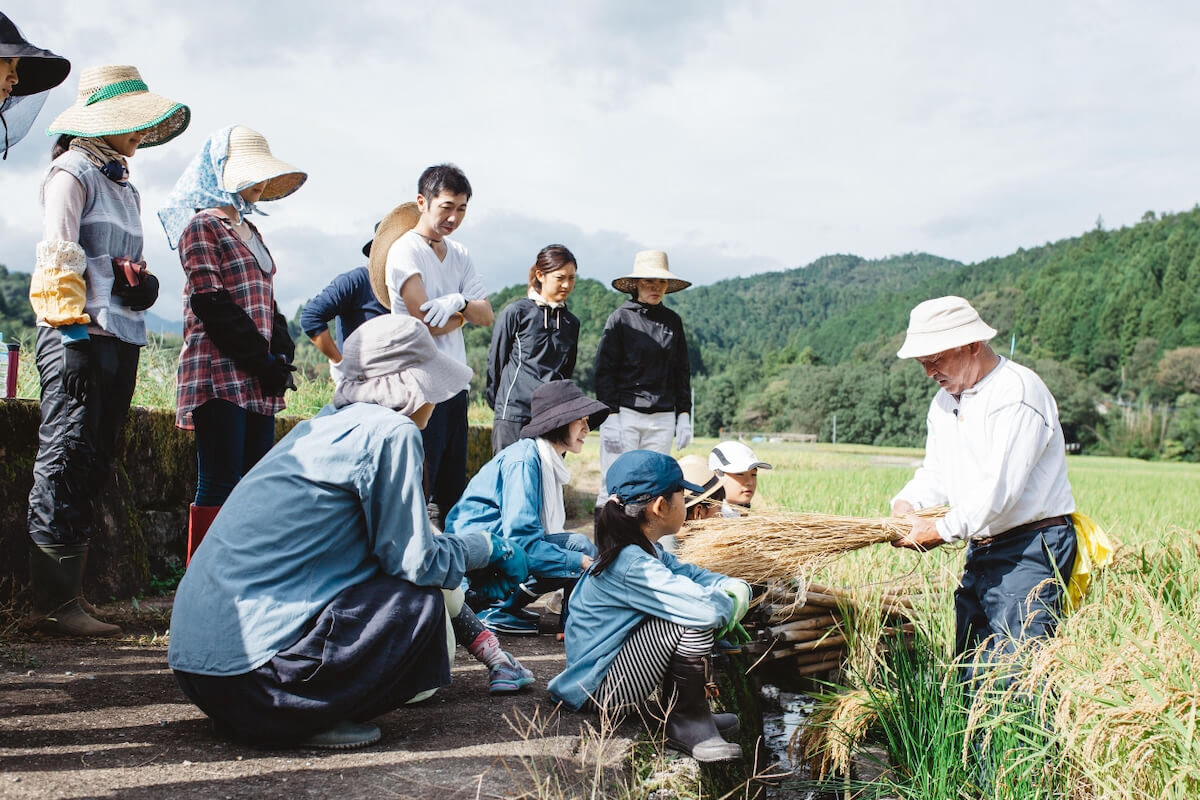
フードハブ・プロジェクト:徳島県神山町で、地域の農業を次世代につなぐために始まったプロジェクト。「地産地食」を合言葉に、自社の農業チームや提携する農家が育てた作物をふんだんに使った食堂・パン屋・食品店を運営している。
—— 働く人の健康についてはどう考えていますか?
「健康じゃなくちゃいけない」と押しつけるとうまくいかないから、自然と健康になっていく環境をつくるのがいいと思っています。たとえばビュッフェ形式の社食の場合、最初にサラダステーションを置いて取りやすくする、とか。
グーグルの休憩室のドリンクやフードを管理していたときに、チョコレートがかなりの数出ていて気になったことがありました。最初は健康のために良くないと思い補充の回数を少なめにしたのですが、途中で「いや、こういうやり方はよくないな」と思い直して、チョコレートを瓶に入れるようにしたんです。そうしたら、開けるのが少し面倒になって、消費量が3分の1に減りました。ちょっと工夫するだけで、人の行動は大きく変わるんです。
同じビルに勤務している人たちが会社の垣根を越えて利用できる“職域食堂”の可能性
—— 2022年10月には、旧九段会館を活用したオフィスビル「九段会館テラス」内に、社食研がプロデュースする社員食堂「九段食堂 KUDAN-SHOKUDO for the Public Good」がオープンしましたね。
東急不動産が展開する会員制シェアオフィス「ビジネスエアポート九段下」に併設していて、社食スペースとカフェスペースを設けています。基本的には九段会館テラスに入居している企業のための食堂ですが、一般の方もランチのピークタイム以降は入れるんですよ。カフェスペースは終日OKです。横が皇居のお堀で、桜が見える絶好のロケーション。僕が近くに住んでいたら絶対入り浸ると思います。
—— 九段食堂のような、同じビルに勤務している人たちが会社の垣根を越えて利用できる“職域食堂”にはどのようなメリットがあるのでしょうか。
日本全体で、社食を持っている企業は22.7%しかありません。社食を新しくつくるには1億円ほどかかりますから、なかなか難しいんですね。それなら、複数の企業が入ったオフィスビルに共通の社食があればいいのではという発想から生まれたのが職域食堂です。デベロッパーにとっては他のオフィスビルとの差別化になるし、入居する企業はイニシャルコストを下げられるので料理への補助を出しやすくなる。社員は500円出せば750円から800円ほどの料理が食べられるし、僕たちもいいものを提供できる。そういうメリットがありますね。
食堂で他社の社員との会話が生まれれば、同じ会社の社員同士で集まるよりもよりイノベーションにつながるでしょう。さらに、地域とも連携できるといいですね。地元の生産者さんや地元の方と交流したり、地域の菜園をみんなで耕してそこで採れたものを使ったり。「社食4.0」と呼んでもいいかもしれません。
—— 利用者が複数の会社にまたがるとなると、社員食堂とはまた違った難しさがあるのではないでしょうか。
企業によって利用のされ方や好みも違ってくるでしょうし、異なるカルチャーを持った企業の社員同士をいかにつなぐかは課題になってくるでしょうね。そこは事前に決めるのではなく、やってみて様子をみながら戦略を練ろうと思っています。運営しながら少しずつ調整していけるところが社食のいいところですから。
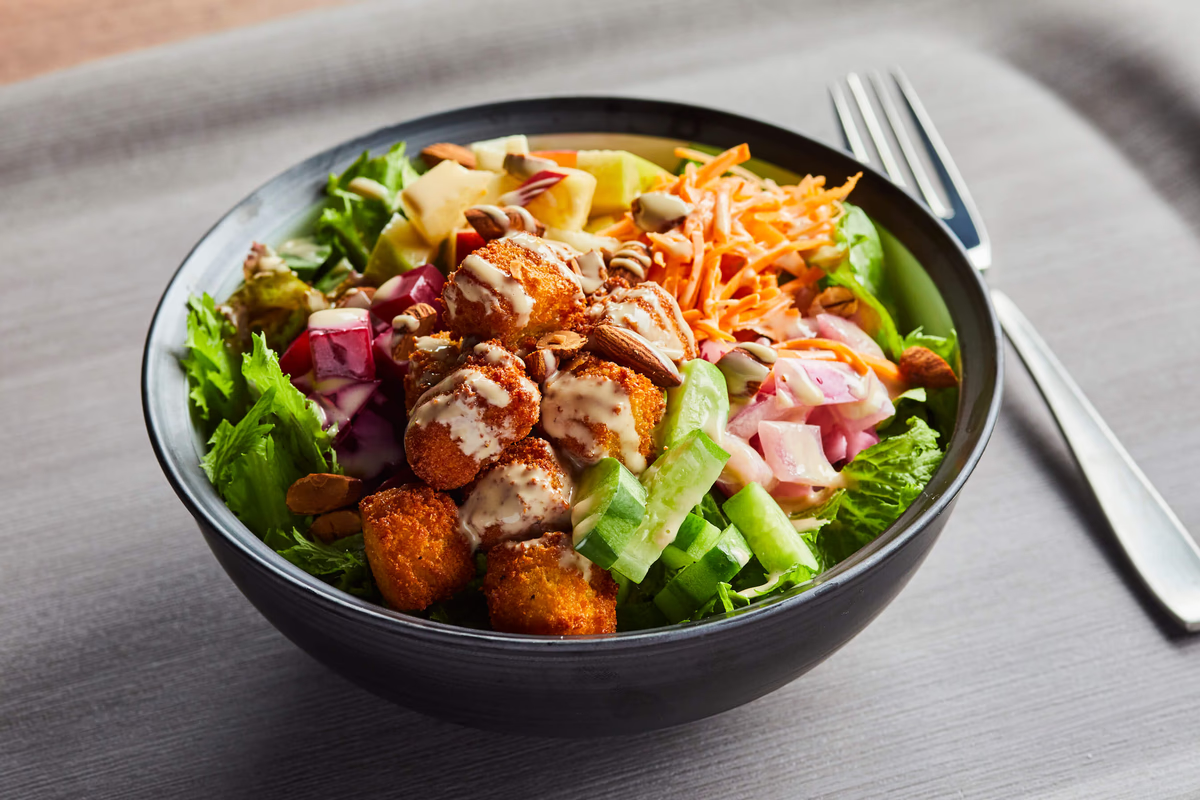
九段食堂の人気メニューのひとつ、サラダボウル
—— 今後、MONOSUS社食研として取り組みたいことはありますか?
いま、再開発まちづくりの一貫として社食をつくるプロジェクトが進んでいます。オフィスビルと高層マンションが建つことになっていて、そこに職域食堂とFarmMart&Friends(MONOSUS社食研が代々木にオープンした「友産友食」をめざす食料品店)のような食料品店が一体化したものを入れられたらと構想しています。
関係性のあるつくり手が育てたものを使った料理を食べられて、「この野菜はおいしいな」と思ったら買って帰ることもできる。オフィスの食と家庭の食が一緒になった、まさに日常の食ですね。それが成功して、ほかの地域でも展開できたらおもしろくなるんじゃないかな。
ただ、いまはまだいろいろと仮説の状態です。Googleのバックグラウンドを元に試行錯誤して、MONOSUS社食研として何ができるかを探っているところ。九段食堂がオープンしてしばらくしたら、「ここはうまくいかなかったな」「でもこっちでは思ってもみなかった可能性が見えてきたね」という話が出てくるはずです。その頃にまたこうして話を聞いていただけたら。
—— はい、またぜひインタビューさせてください! 楽しみにしています。
